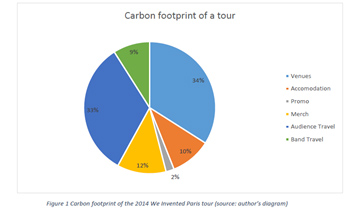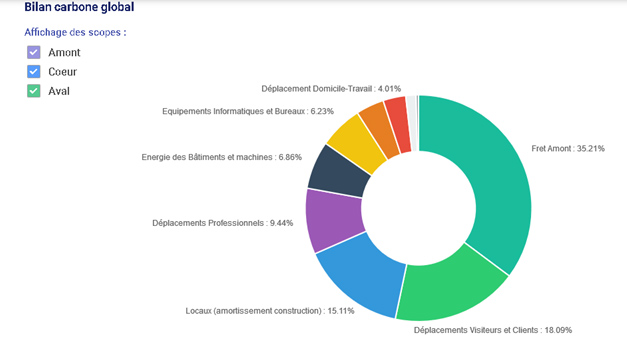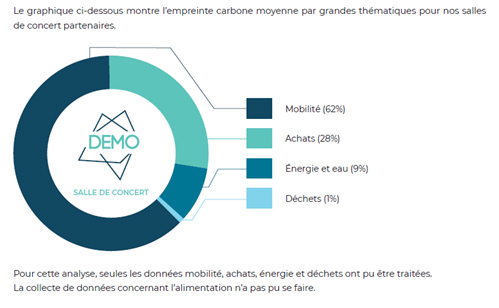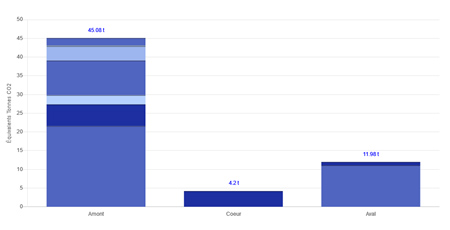In her article Cultural commitment for environmental action, Chiara Badiali of the British organisation Julie’s Bicycle, encourages the jazz community to put the environmental and climate issue at the heart of its considerations, and to think in terms of major changes. This is the difficult but necessary task that the Périscope, a venue for innovative music located in the heart of Lyon, has set for itself. Its aim is to experiment and “design” what a low-carbon jazz and improvised music sector could be, and to put this ecosystem in motion in the face of the climate emergency.
Until a few years ago, the notion of a carbon footprint was almost foreign to the music industry’s vocabulary. On the contrary, some organisations now want to have their carbon footprint done in order to “compensate” and be able to communicate on their carbon neutrality. While this can certainly be seen as a positive sign that the players in the music and cultural sector in general are taking these issues into account, this craze is not without raising questions about the understanding of this tool (because it is one) and the methodological choices made.
So, let’s go back to the basics. In very simple terms, a carbon footprint is a methodology for measuring the greenhouse gas emissions (GHG), in other words the impact on climate change, of a company, a product, an event, a community, a country, a festival, a venue, etc. In France, this methodology was published by ADEME in 2004. It takes into account all the greenhouse gases defined by the IPCC (Intergovernmental Panel on Climate Change) for all its flows. Its fields of application are divided into 3 categories of emissions called Scope 1, 2 and 3 (or “value chain” emissions):
| SCOPE 1 | Emissions from owned or operated assets – oil-fired heating, gas boiler, owned vehicles, generators, etc. |
| SCOPE 2 | Emissions from the energy you buy (which is produced elsewhere) – electricity. |
| SCOPE 3 | Emissions from everything else – business travel, purchased goods and services, transport and distribution, food, waste treatment, investments, audience travel, etc |
A certain number of carbon assessments are simplified, i.e. they focus on the notion of responsibility for emissions, by evacuating all or part of Scope 3 emissions. However, the interest and relevance of identifying and taking into account all of these scopes is multiple. In a transition process, a global assessment of GHG emissions and the involvement of stakeholders upstream and downstream will make it possible to identify a greater number of reduction actions to be implemented. If the upstream and downstream, i.e. the flows on which the activity depends, are excluded, the result obtained risks being very simplistic.
The question to ask yourself when identifying the flows to be integrated is the following: is my activity unchanged if I remove this or that flow? For a theatre, will the activity be significantly impacted if I remove the “artist mobility” or the “audience mobility” flow? If there was any doubt about this, it would seem that the successive lockdowns we have just experienced have clearly answered this question…
Beyond the teams’ prior commitment to environmental issues (waste management, pooling and repair of equipment, etc.), the reflection comes from the awareness of the responsibility of organisations receiving public funding.
The Périscope has therefore chosen to focus on the carbon issue and to embark on this exercise of introspection. Beyond the teams’ prior commitment to environmental issues (waste management, pooling and repair of equipment, etc.), the reflection comes from taking into account the responsibility of organisations receiving public funding, the recognition of the prescriptive role of culture, as well as the analysis of risks: exposure due to international programming, increased transport costs, possible eco-conditioning of funding, broadening of the legislative framework of the carbon footprint (currently compulsory for companies with more than 500 employees in metropolitan France and more than 250 employees in the overseas departments and territories, local authorities with more than 50,000 inhabitants, public establishments with more than 250 employees and State services).
Methodological choices
For this purpose, The Périscope joined in 2020 the WeCount Climate Promotion alongside other structures and companies from diverse sectors in Lyon. The startup WeCount has indeed set up this training and collective support approach for any type of company wishing to measure and reduce its greenhouse gas emissions and accelerate its low-carbon transition. The Periscope team was thus trained to carry out its carbon assessment, to define a climate strategy compatible with the Paris Agreements and to implement a climate action plan with the help of the dedicated platform.
The method remains fairly standard, including training on carbon issues, definition of the scope, mapping of flows and a The method remains fairly standard, including training on carbon issues, definition of the scope, mapping of flows and a great deal of data collection work which is then integrated into the platform
The method remains fairly standard, including training on carbon issues, definition of the scope, mapping of flows and a The method remains fairly standard, including training on carbon issues, definition of the scope, mapping of flows and a great deal of data collection work which is then integrated into the platform. However, this Climate Promotion is unique in that it is based on a collective approach, with peer-to-peer workshops, the involvement of numerous experts and pioneers, and the empowerment of participants in the management and implementation of the assessment.
For example, this was an opportunity for the team to point out certain difficulties linked to the specificities of the cultural sector and the types of activities that are specific to them, and to which the carbon footprint model does not respond. For example, the Périscope does not only offer concerts, but also a wide range of activities such as rehearsals, residencies, cultural activities, workshops, European cooperation, support, etc. This led to many questions and exchanges when choosing the functional unit, which is the “quantified performance of a product system intended to be used as a reference unit in a life cycle assessment” (definition taken from ISO 14040:2006). In other words, it is the unit that by convention focuses on the main activities and allows for comparison of performance between them. Thus, for a country, its carbon footprint will be divided by its number of inhabitants, in order to compare countries. For a company, this unit could be the number of employees, or its turnover. For the Périscope, the number of concerts offered or the number of spectators are not relevant functional units as they do not reflect the whole of the activities. The choice was therefore made to use a unit representing the number of working days/number of artists hosted.
The choice was also made to integrate the artists’ tours, qualified as “upstream freight” on the platform. For each group and/or artist hosted at the Périscope, the team enters into a spreadsheet the mileage data corresponding to the transport between the origin and the destination as well as the transport between the gigs (200km by car on average). The total obtained is then divided by the number of shows on the tour. The argument against this choice could be the double counting one: if the artists or their producers/bookers count their own carbon emissions, why count them twice? What is important to understand here is that double or even triple counting is not a problem. A carbon footprint is not an accounting exercise, but a tool to understand your emissions and to see if actions can be taken to reduce them. In the same way, it can be interesting for a booker/band to calculate the impact of its tour by integrating the share of public travel, as is the case in the example below taken from the Green Touring guide. For instance, this can be an interesting tool and lever for a better cooperation between programmers and producers.

About the results
For the year 2019, which is its reference year, the Periscope’s carbon footprint represents 61.26TeqCO2, with the following breakdown:

Unsurprisingly, transport is the largest source of emissions from the venue’s annual activities, as is the case for the vast majority of cultural venues and events, and the tertiary sector in general, with two thirds of total emissions.
This is a trend that can be seen for concert halls, as the DEMO project’s analysis of the emissions of the participating venues (France and Belgium) also shows:

For the Périscope, the share linked to the artists’ travel (upstream freight) covers half of the total travel item. Next comes the audience travel with a little less than 30% of the emissions linked to travel, followed by the travel of the team (home-work and professional travel) which covers 20% of travel.
In comparison, for the 4 Écluses venue in Dunkerque, travel represents 75% of the total carbon footprint, and artists’ travel only covers 5% of the total travel item.
The DEMO study also highlights the strong impact of audience travel on the carbon footprint, a fact that has already been highlighted for many years by Julie’s Bicycle and is now becoming well known in the sector.
In comparison, for the Salle des 4 écluses in Dunkerque, travel represents 75% of the total carbon footprint, and artists’ travel only covers 5% of the total travel item.
The DEMO study also highlights the strong impact of visitor travel on the carbon footprint, a fact that has been highlighted for many years by the Julie’s Bicycle organisation, and is becoming well known in the sector.

Source : étude Le Diagnostic environnemental DEMO (2020)
The Périscope is located in the city centre, close to the train station, very close to public transport, and has an audience that uses soft mobility (cycling, walking, etc.). The venue does not have a car park, and parking is not free in the vicinity, with prohibitive rates. All these elements may explain this lower figure than the average for other venues. However, these data are mainly based on estimates, and must be refined, particularly with the help of an audience study.
It is also important to note that while the percentage of artist travel can be explained by the international programming, the relatively low figure for the share of audience travel makes the share of artist travel very important. The methodological choice of integrating these trips also makes it difficult to compare with other music venue that use a different calculation method.
The depreciation of the premises represents 15% of the carbon emissions, and this is a share that will remain unchanged over the course of the next assessments. No action can be considered on this part, since no one has control over it. Energy (electricity) accounts for just under 7%, and equipment (computers and office equipment) for 6% of total emissions. Next come food with 3%, and finally waste, waste treatment and packaging with just under 2%.
The diagram below shows the distribution of the Periscope’s emissions according to its value chain, with Scope 1 and 2 at the heart, and Scope 3 upstream and downstream.

All of this data was then used to define a trajectory and an action plan for the reduction of GHG emissions, corresponding to the Periscope’s activities by 2030, in accordance with the Paris agreements. The team already had some ideas in mind, but the carbon assessment exercise allowed to clarify these ideas, and to decide on the decisions to be taken. 3 possible scenarios: 1.5°C, Well Below 2°C and 2°C. The Périscope wanted to align itself with a 1.5°C trajectory, but once the analyses were produced, it was found that this choice was not realistic in view of the objectives that would have to be reached, and the Well Below 2°C trajectory was chosen. This means for the Périscope a 27% reduction of its total emissions by 2030, with the following breakdown, while keeping its core business and the richness of its activities and interventions:
| UPSTREAM | -17,24% Transport of artists (work on tour organisation) Food (vegetarian meals) |
| MIDDLE | -28% Green energy consumption (switch for green supplier) Limiting energy consumption (renovation, insulation |
| DOWNSTREAM | Audience and clients travel (public transport, soft mobility) Waste reduction |
In parallel to these short- and medium-term actions, the Périscope wishes to pursue the collective dynamic on the carbon issue instilled by the Climate Promotion and is taking its partners on board. First, work is being carried out within the European Footprints project with participating and selected artists, venues and producers/agents, by organising round tables and awareness-raising workshops, but also by working together on more sustainable tours, by extending their duration and reducing the distances between each date. This sharing of tours with other venues and/or festivals is one of the levers that is also put forward by the Shift Project in its interim report “Decarbonising Culture”.
The Périscope team has also set up an internal questionnaire to question the need for professional travel and to compare the different possible modes of transport.
The Périscope also addresses the carbon issue within the AJC network, a collective of 80 presenters (festivals, clubs, accredited stages, etc.) who are also involved in various collective projects. To this end, it has launched an experiment with 10 organisations (8 members of AJC and 2 partners of the Footprints project: Oslo Jazz Festival and Bimhuis in Amsterdam). Each of these venues will carry out its carbon footprint following the same methodology as that of the Periscope, i.e. taking into account Scope 1, 2 and 3 and the artists’ tours for the year 2019, which will allow a wider vision of the impact of the jazz sector and will provide orders of magnitude and a common roadmap. This ongoing study will give rise to a first public presentation at the Jazz(Ra) event in Clermont-Ferrand at the end of November.
The Périscope has therefore launched an experiment, it is projecting itself in time and involving its partners and stakeholders, while waiting to involve the whole sector. Looking at the music industry as a whole, this may seem like a drop in the ocean. A modest band playing 30-40 gigs in small to medium-sized venues has an annual carbon footprint of over 20 tonnes in Europe alone. As the Shift Project report highlights, a festival on the outskirts with 280,000 people over four days will emit around 13,800 TeqCo2. But by demonstrating the importance of the music industry moving onto a low-carbon trajectory, through its experimentation and beyond the prevention of the risks it faces, the jazz and improvised music sector can lead the way in promoting a more frugal and sustainable model.


